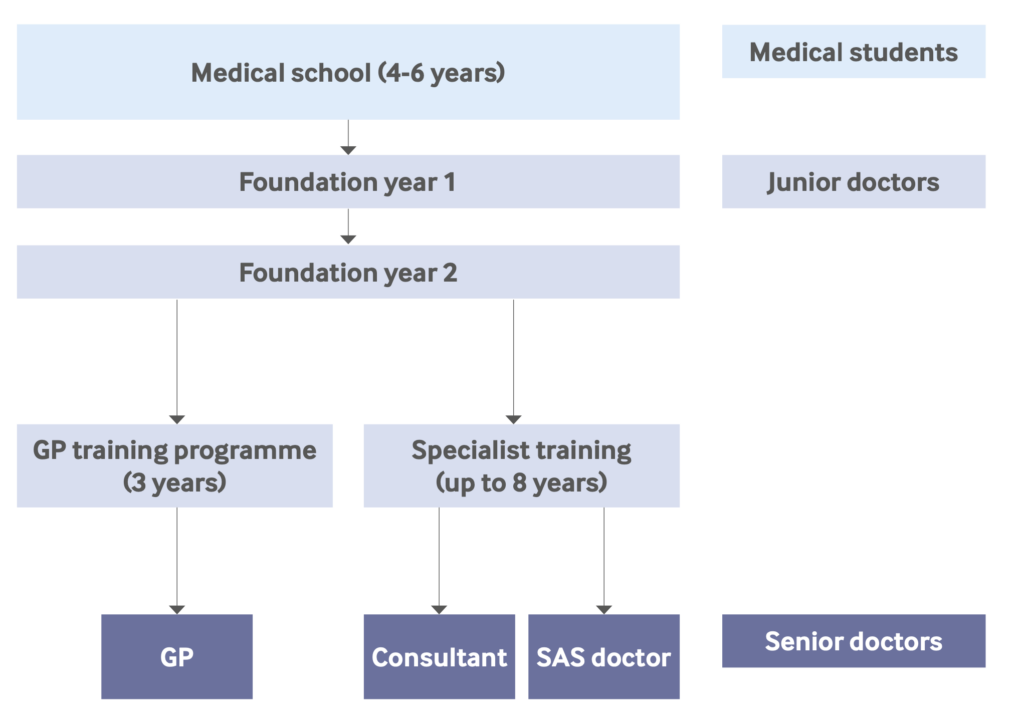The NHS crisis in the UK
The National Health Service (NHS) in the UK is currently facing a lot of problems. Central to this crisis are the ongoing strikes by junior doctors, who are advocating for better pay and working conditions. Being aware of the causes and implications of these strikes is crucial to understanding the broader issues affecting the NHS today.
Background on the NHS
The NHS was founded in 1948 to provide free healthcare services to all UK residents. Over the decades, it has become a cornerstone of British society.
“We used to have what was known as the best health service for everybody in the world,”
Esther Watson-Jones, a retired medical doctor, said.
However, in recent years, the NHS has struggled with underfunding, staff shortages, and increasing patient demand. These challenges have significantly impacted the quality of care and the working conditions for healthcare professionals.
Types of healthcare professionals
Who are junior doctors?
Junior doctors are doctors who just finished their studies, which are followed by a 2-year work-based training programme. After completing the first year, they obtain full registration within the General Medical Council (GMC). After completing the second year, they are allowed to apply for further study and training in a specialised area of medicine. That can take up to 8 years depending on the area, and within that time they are still considered junior doctors.
Who are senior doctors?
Senior doctors are doctors who finished their training and can continue working without supervision. They are usually split between GPs, consultants, and SAS doctors.
Consultants
Consultants are doctors responsible for leading a hospital team to deliver patients’ care with the best possible outcomes. They have completed at least 6 years of training and are required to keep themselves in their speciality within a system called continuous professional development (CPD).
SAS doctors
SAS doctors are Staff Grade, Associate Specialist and Specialty Doctors. They have completed a minimum of 4 years of postgraduate studies including two years in their chosen speciality. There are more than 60 different specialties but sometimes they are also seen as part-time GPs (General Practitioners).

Reasons behind the junior doctors’ strike
The strikes by junior doctors are primarily driven by issues of pay restoration and working conditions that started with the financial crisis in 2008/9. This led to a pay decrease of 26% as the Government cut social spending, and the NHS budget comes out of the social spending of the GDP (Gross domestic product).
Esther Watson-Jones, a retired medical doctor, added:
“Having to pay full fees all through their medical training, they are in terrible debt both for their fees and accommodation during their training. And they’re not really getting a salary, which is enabling them to buy their own property, get married, and have children. They’ve just got this huge debt around their necks and they’re working so hard. And with COVID, they just feel that they’re not valued, and they can’t cope with the financial debt they’re in.”
Also, all the mentioned above negatively affect junior doctors’ mental health. A survey from 2023 run by BMA (British Medical Association), the trade union and professional body for doctors in the UK shows that in the previous year, 78% of junior doctors felt unwell because of work-related stress. It is a vicious circle because when a doctor struggles, they will take a day off, which impacts the shift of another doctor who needs to check on more patients. That leads to another burnt-out doctor that takes a day off, and so on.

Impact of the junior doctors’ strike
The strikes have had a huge impact on patient care. Hundreds of thousands of patients have experienced delays in receiving appointments and surgeries, further straining an already overwhelmed system.
Professor Sir Stephen Powis, NHS national medical director, said for NHS news:
“It’s not possible to have 1 in every 10 days affected by strikes for over a year without it having a huge impact on services, patients, their families, and staff.”
The strike by junior doctors in January caused the disruption of over 113,000 hospital appointments and resulted in at least 23,000 staff being absent on weekdays. Overall, strikes have affected more than 1.3 million hospital appointments within the NHS. Junior doctors represent about half of all doctors in the NHS, so the industrial actions will inevitably cause more issues.
Government and BMA’s responses
In 2022, junior doctors were presented with a pay increase of 2%, which was both insulting and significantly below the rate of inflation. So far though, that was the only help they were offered by the Government, and so the strikes continued.
Reacting to the BMA’s announcement of an additional round of junior doctors’ strikes, Matthew Taylor, chief executive of the NHS Confederation, said for NHS Confederation:
“It is deeply disappointing that the BMA and government have not been able to find a solution to the ongoing pay debate and as a result junior doctors will be striking again.”

